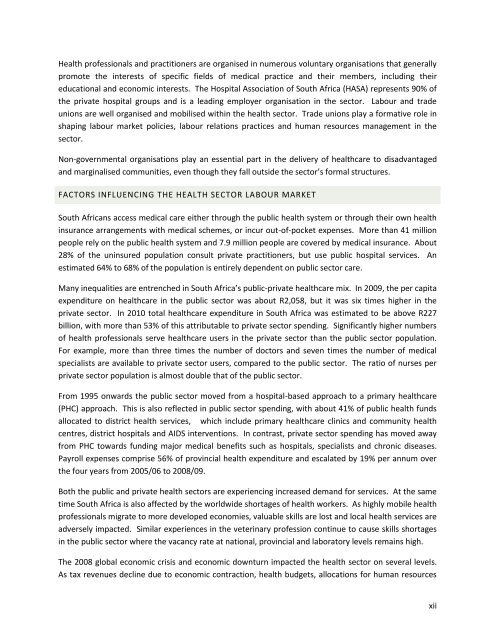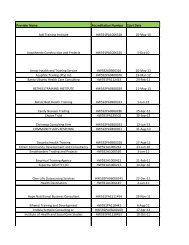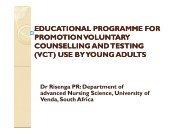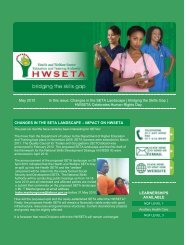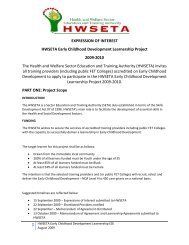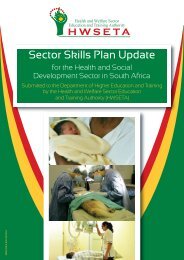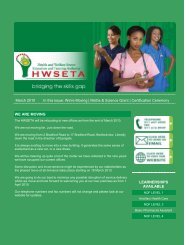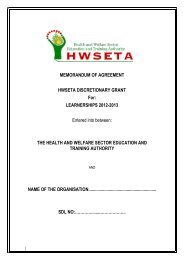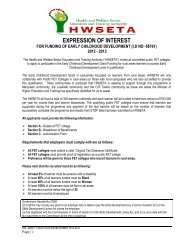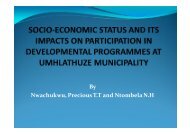sector skills plan for the health sector in south africa
sector skills plan for the health sector in south africa
sector skills plan for the health sector in south africa
Create successful ePaper yourself
Turn your PDF publications into a flip-book with our unique Google optimized e-Paper software.
Health professionals and practitioners are organised <strong>in</strong> numerous voluntary organisations that generally<br />
promote <strong>the</strong> <strong>in</strong>terests of specific fields of medical practice and <strong>the</strong>ir members, <strong>in</strong>clud<strong>in</strong>g <strong>the</strong>ir<br />
educational and economic <strong>in</strong>terests. The Hospital Association of South Africa (HASA) represents 90% of<br />
<strong>the</strong> private hospital groups and is a lead<strong>in</strong>g employer organisation <strong>in</strong> <strong>the</strong> <strong>sector</strong>. Labour and trade<br />
unions are well organised and mobilised with<strong>in</strong> <strong>the</strong> <strong>health</strong> <strong>sector</strong>. Trade unions play a <strong>for</strong>mative role <strong>in</strong><br />
shap<strong>in</strong>g labour market policies, labour relations practices and human resources management <strong>in</strong> <strong>the</strong><br />
<strong>sector</strong>.<br />
Non-governmental organisations play an essential part <strong>in</strong> <strong>the</strong> delivery of <strong>health</strong>care to disadvantaged<br />
and marg<strong>in</strong>alised communities, even though <strong>the</strong>y fall outside <strong>the</strong> <strong>sector</strong>’s <strong>for</strong>mal structures.<br />
FACTORS INFLUENCING THE HEALTH SECTOR LABOUR MARKET<br />
South Africans access medical care ei<strong>the</strong>r through <strong>the</strong> public <strong>health</strong> system or through <strong>the</strong>ir own <strong>health</strong><br />
<strong>in</strong>surance arrangements with medical schemes, or <strong>in</strong>cur out-of-pocket expenses. More than 41 million<br />
people rely on <strong>the</strong> public <strong>health</strong> system and 7.9 million people are covered by medical <strong>in</strong>surance. About<br />
28% of <strong>the</strong> un<strong>in</strong>sured population consult private practitioners, but use public hospital services. An<br />
estimated 64% to 68% of <strong>the</strong> population is entirely dependent on public <strong>sector</strong> care.<br />
Many <strong>in</strong>equalities are entrenched <strong>in</strong> South Africa’s public-private <strong>health</strong>care mix. In 2009, <strong>the</strong> per capita<br />
expenditure on <strong>health</strong>care <strong>in</strong> <strong>the</strong> public <strong>sector</strong> was about R2,058, but it was six times higher <strong>in</strong> <strong>the</strong><br />
private <strong>sector</strong>. In 2010 total <strong>health</strong>care expenditure <strong>in</strong> South Africa was estimated to be above R227<br />
billion, with more than 53% of this attributable to private <strong>sector</strong> spend<strong>in</strong>g. Significantly higher numbers<br />
of <strong>health</strong> professionals serve <strong>health</strong>care users <strong>in</strong> <strong>the</strong> private <strong>sector</strong> than <strong>the</strong> public <strong>sector</strong> population.<br />
For example, more than three times <strong>the</strong> number of doctors and seven times <strong>the</strong> number of medical<br />
specialists are available to private <strong>sector</strong> users, compared to <strong>the</strong> public <strong>sector</strong>. The ratio of nurses per<br />
private <strong>sector</strong> population is almost double that of <strong>the</strong> public <strong>sector</strong>.<br />
From 1995 onwards <strong>the</strong> public <strong>sector</strong> moved from a hospital-based approach to a primary <strong>health</strong>care<br />
(PHC) approach. This is also reflected <strong>in</strong> public <strong>sector</strong> spend<strong>in</strong>g, with about 41% of public <strong>health</strong> funds<br />
allocated to district <strong>health</strong> services, which <strong>in</strong>clude primary <strong>health</strong>care cl<strong>in</strong>ics and community <strong>health</strong><br />
centres, district hospitals and AIDS <strong>in</strong>terventions. In contrast, private <strong>sector</strong> spend<strong>in</strong>g has moved away<br />
from PHC towards fund<strong>in</strong>g major medical benefits such as hospitals, specialists and chronic diseases.<br />
Payroll expenses comprise 56% of prov<strong>in</strong>cial <strong>health</strong> expenditure and escalated by 19% per annum over<br />
<strong>the</strong> four years from 2005/06 to 2008/09.<br />
Both <strong>the</strong> public and private <strong>health</strong> <strong>sector</strong>s are experienc<strong>in</strong>g <strong>in</strong>creased demand <strong>for</strong> services. At <strong>the</strong> same<br />
time South Africa is also affected by <strong>the</strong> worldwide shortages of <strong>health</strong> workers. As highly mobile <strong>health</strong><br />
professionals migrate to more developed economies, valuable <strong>skills</strong> are lost and local <strong>health</strong> services are<br />
adversely impacted. Similar experiences <strong>in</strong> <strong>the</strong> veter<strong>in</strong>ary profession cont<strong>in</strong>ue to cause <strong>skills</strong> shortages<br />
<strong>in</strong> <strong>the</strong> public <strong>sector</strong> where <strong>the</strong> vacancy rate at national, prov<strong>in</strong>cial and laboratory levels rema<strong>in</strong>s high.<br />
The 2008 global economic crisis and economic downturn impacted <strong>the</strong> <strong>health</strong> <strong>sector</strong> on several levels.<br />
As tax revenues decl<strong>in</strong>e due to economic contraction, <strong>health</strong> budgets, allocations <strong>for</strong> human resources<br />
xii


